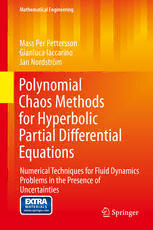
Polynomial Chaos Methods for Hyperbolic Partial Differential Equations: Numerical Techniques for Fluid Dynamics Problems in the Presence of Uncertainties PDF
Preview Polynomial Chaos Methods for Hyperbolic Partial Differential Equations: Numerical Techniques for Fluid Dynamics Problems in the Presence of Uncertainties
Mathematical Engineering Mass Per Pettersson Gianluca Iaccarino Jan Nordström Polynomial Chaos Methods for Hyperbolic Partial Diff erential Equations Numerical Techniques for Fluid Dynamics Problems in the Presence of Uncertainties Mathematical Engineering Serieseditors ClausHillermeier:UniversitätderBundeswehrMünchen,Germany JörgSchröder:UniversitätDuisburg-Essen,Germany BernhardWeigand:InstituteofAerospaceThermodynamics, UniversitätStuttgart,Germany. Moreinformationaboutthisseriesathttp://www.springer.com/series/8445 Mass Per Pettersson (cid:129) Gianluca Iaccarino Jan Nordström Polynomial Chaos Methods for Hyperbolic Partial Differential Equations Numerical Techniques for Fluid Dynamics Problems in the Presence of Uncertainties 123 MassPerPettersson GianlucaIaccarino UniResearch DepartmentofMechanicalEngineering Bergen,Norway andInstituteforComputational andMathematicalEngineering JanNordström StanfordUniversity,USA DepartmentofMathematics ComputationalMathematics LinköpingUniversity Sweden Additionalmaterialtothisbookcanbedownloadedfromhttp://extras.springer.com. ISSN2192-4732 ISSN2192-4740 (electronic) MathematicalEngineering ISBN978-3-319-10713-4 ISBN978-3-319-10714-1 (eBook) DOI10.1007/978-3-319-10714-1 LibraryofCongressControlNumber:2014950671 SpringerChamHeidelbergNewYorkDordrechtLondon ©SpringerInternationalPublishingSwitzerland2015 Thisworkissubjecttocopyright.AllrightsarereservedbythePublisher,whetherthewholeorpartof thematerialisconcerned,specificallytherightsoftranslation,reprinting,reuseofillustrations,recitation, broadcasting,reproductiononmicrofilmsorinanyotherphysicalway,andtransmissionorinformation storageandretrieval,electronicadaptation,computersoftware,orbysimilarordissimilarmethodology nowknownorhereafterdeveloped. Theuseofgeneraldescriptivenames,registerednames,trademarks,servicemarks,etc.inthispublication doesnotimply,evenintheabsenceofaspecificstatement,thatsuchnamesareexemptfromtherelevant protectivelawsandregulationsandthereforefreeforgeneraluse. Thepublisher,theauthorsandtheeditorsaresafetoassumethattheadviceandinformationinthisbook arebelievedtobetrueandaccurateatthedateofpublication.Neitherthepublishernortheauthorsor theeditorsgiveawarranty,expressorimplied,withrespecttothematerialcontainedhereinorforany errorsoromissionsthatmayhavebeenmade. Printedonacid-freepaper SpringerInternational PublishingAGSwitzerlandispartofSpringerScience+Business Media(www. springer.com) Preface Uncertainty quantification in computational physics is a broad research field that has spurred increasing interest in the last two decades, partly due to the growth of computer power. The objective of this textbook is the analysis and design of numericaltechniquesforsolvingequationsrepresentingconservationlawssubject touncertainty.Inparticular,thefocusisonstochasticGalerkinmethodsthatrequire non-trivial development of new numerical solvers for hyperbolic and mixed type problems. There are already textbookscovering the stochastic Galerkin and other polynomial chaos methods from a general perspective, cf. [1–3]: this textbook is morespecializedinitsscope.Toenhanceunderstandingofthematerialpresented, we provideexercisesandcodescriptsandbuildingblocksthatcanbeextendedto newproblemsettings. The interest in stochastic Galerkin methods has burgeoned because of the availability of ever more powerful computers that can handle the computational cost inherent to large system implementations. Moreover, these methods have positive numerical properties that make them attractive for handling complex situations.Specifically,themathematicalformulationleadstosystemsofequations thatresembletheoriginalconservationlaws,allowingustomakeextensiveuseof availablenumericalanalysistoolsandtechniques.Atthesametime,thestochastic Galerkinmethodisanattractivealternativeforcomplexproblemsinvolvingpartial differentialequationsandmultipleuncertainvariables(hereinreferredtoasstochas- ticdimensions). Chapters 1–3 introduce and give a brief overview of the basic concepts of uncertaintyquantificationandthestochasticGalerkinmethod.Chapter4isdevoted to spatial discretization methods for conservation laws under uncertainty. In par- ticular, we introduce the so-called SBP-SAT finite difference technique based on summation-by-parts operators (SBP) and weak boundary conditions using simultaneous approximation terms (SAT). The SBP-SAT schemes allow for the design of stable high-order accurate schemes. Summation by parts is the discrete equivalentofintegrationbypartsandthematrixoperatorsthatarepresentedleadto energyestimatesthat,inturn,leadtoprovablestabilityincombinationwiththeSAT terms.Thesemidiscretestabilityfollowsnaturallyfromthecontinuousanalysisof v vi Preface well-posednesswhichprovidestheboundaryconditionsintheSBP-SATtechnique. Chapters5–9presentin-depthanalysisoflinearandnonlinearstochasticGalerkin conservationlaws, complementedby exercises and scripts. We providethe reader with computercodesfor solvingthe advection-diffusionequationand the inviscid Burgers’ equation with the stochastic Galerkin method. These codes can also be usedastemplatesforextensiontomorecomplexproblems. Thistextbookisintendedforanaudiencewithsomepriorknowledgeofuncer- taintyquantification.Basic conceptsofprobabilitytheory,statistics andnumerical analysisarealsoassumedtobefamiliartothereader.Foramoregeneralexposition and further details on the basic concepts, we refer to the existing literature in the field. Thistextbookhasbenefitedfromnumerouscollaborationsanddiscussionswith Alireza Doostan (who co-authored the material contained in Chap.5), Antony Jameson, Xiangyu Hu, Rémi Abgrall and Paul Constantine. We would like to thankMargotGerritsenforconstructivefeedbackandsuggestionsforimprovement. Financial support was partially provided by KAUST under the Stanford/KAUST AcademicExcellenceAlliance(AEA)collaboration(UDGIAAward48803).Gian- lucaIaccarinowishestothanktheBorristercrewforsupportincompletingthefinal revisionofthetext. Bergen,Norway MassPerPettersson Stanford,USA GianlucaIaccarino Linköping,Sweden JanNordström References 1.Xiu D (2010) Numerical methods for stochastic computations: a spectral method approach. PrincetonUniversityPress,Princeton.http://www.worldcat.org/isbn/9780691142128 2.Le Maître OP, Knio OM (2010) Spectral methods for uncertainty quantification, 1st edn. Springer,Dordrecht/NewYork 3.SmithR(2013)Uncertaintyquantification:theory,implementation,andapplications.Computa- tionalscienceandengineering.SIAM,Philadelphia Contents PartI IntroductoryConceptsandBackground 1 Introduction .................................................................. 3 1.1 TheoryforInitialBoundaryValueProblems......................... 4 1.1.1 TheContinuousProblem..................................... 5 1.1.2 TheSemidiscreteProblem.................................... 6 1.2 Outline ................................................................. 7 References..................................................................... 8 2 RandomFieldRepresentation.............................................. 11 2.1 Karhunen-LoèveExpansion........................................... 12 2.2 GeneralizedChaosExpansions ....................................... 13 2.2.1 GeneralizedPolynomialChaosExpansion.................. 13 2.2.2 HaarWaveletExpansion...................................... 16 2.2.3 MultiwaveletExpansion...................................... 17 2.2.4 ChoiceofBasisFunctionsforGeneralizedChaos.......... 20 2.3 Exercises............................................................... 20 References..................................................................... 20 3 PolynomialChaosMethods................................................. 23 3.1 IntrusiveMethods...................................................... 23 3.1.1 StochasticGalerkinMethods................................. 23 3.1.2 Semi-intrusiveMethods ...................................... 24 3.2 Non-intrusiveMethods................................................ 25 3.2.1 InterpolationandIntegrationApproaches................... 25 3.2.2 SpectralProjection............................................ 26 3.2.3 StochasticMulti-elements.................................... 27 3.3 Exercises............................................................... 28 References..................................................................... 28 vii viii Contents 4 NumericalSolutionofHyperbolicProblems.............................. 31 4.1 Summation-by-PartsOperators ....................................... 32 4.1.1 RecipeforConstructingaScheme........................... 32 4.1.2 TheContinuousProblem..................................... 33 4.2 Analysis................................................................ 33 4.2.1 Well-Posedness ............................................... 33 4.2.2 Stability........................................................ 34 4.2.3 ConvergenceforFiniteTime................................. 36 4.2.4 AnErrorBoundinTime...................................... 37 4.2.5 ArtificialDissipationOperators.............................. 38 4.3 Shock-CapturingMethods ............................................ 38 4.3.1 MUSCLScheme.............................................. 38 4.3.2 HLLRiemannSolver......................................... 40 4.4 TimeIntegration....................................................... 40 4.5 Exercises............................................................... 42 References..................................................................... 43 PartII ScalarTransportProblems 5 LinearTransportUnderUncertainty...................................... 47 5.1 ProblemDefinition .................................................... 48 5.1.1 UncertaintyandSolutionProcedure......................... 49 5.1.2 StochasticGalerkinProjection............................... 49 5.1.3 DiagonalizationoftheStochasticGalerkinSystem......... 52 5.2 TheEigenvaluesoftheDiffusionMatrixB .......................... 53 5.2.1 GeneralBoundsontheEigenvaluesofB.................... 53 5.2.2 LegendrePolynomialRepresentation........................ 54 5.2.3 HermitePolynomialRepresentation......................... 54 5.3 BoundaryConditionsforWell-Posedness............................ 55 5.4 MonotonicityoftheSolution ......................................... 56 5.4.1 Second-OrderOperators...................................... 56 5.4.2 Fourth-OrderOperators....................................... 59 5.5 StabilityoftheSemidiscretizedProblem............................. 60 5.5.1 TheInitialValueProblem:vonNeumannAnalysis......... 60 5.5.2 TheInitialBoundaryValueProblem......................... 62 5.5.3 EigenvaluesoftheTotalSystemMatrix..................... 66 5.5.4 ConvergencetoSteady-State................................. 69 5.6 NumericalResults ..................................................... 71 5.6.1 TheInviscidLimit ............................................ 72 5.6.2 Steady-StateCalculations .................................... 76 5.7 SummaryandConclusions............................................ 77 5.8 SupplementaryCodes ................................................. 78 5.9 Exercises............................................................... 78 References..................................................................... 79 Contents ix 6 NonlinearTransportUnderUncertainty.................................. 81 6.1 PolynomialChaosExpansionofBurgers’Equation................. 82 6.1.1 EntropyandEnergyEstimatesfortheM D2Case ........ 83 6.1.2 DiagonalizationoftheSystemMatrixA.uM/ ............... 84 6.2 AReferenceSolution.................................................. 85 6.2.1 RegularityDeterminedbythegPCExpansionOrder....... 87 6.3 Well-Posedness ........................................................ 88 6.3.1 TheImportanceofBoundaryConditions.................... 90 6.4 EnergyEstimatesforStability ........................................ 90 6.4.1 ArtificialDissipationforEnhancedStability................ 92 6.5 TimeIntegration....................................................... 93 6.6 EigenvalueApproximation............................................ 93 6.7 EfficiencyofthePolynomialChaosMethod......................... 95 6.7.1 NumericalConvergence...................................... 96 6.8 TheoreticalResultsandInterpretation................................ 98 6.8.1 AnalysisofCharacteristics:DisturbedCosineWave........ 98 6.9 SummaryandConclusions............................................ 106 6.10 SupplementaryCodes ................................................. 107 6.11 Exercises............................................................... 107 References..................................................................... 108 7 BoundaryConditionsandData ............................................ 111 7.1 DependenceonAvailableData ....................................... 111 7.1.1 CompleteSetofData......................................... 112 7.1.2 IncompleteSetofBoundaryData............................ 112 7.1.3 DiscussionoftheResultswithIncompleteSetofData..... 118 7.2 SummaryandConclusions............................................ 120 7.3 Exercises............................................................... 120 Reference...................................................................... 121 PartIII EulerEquationsandTwo-PhaseFlow 8 gPCfortheEulerEquations................................................ 125 8.1 EulerEquationswithInputUncertainty ............................. 126 8.1.1 FormulationinRoeVariables ................................ 127 8.1.2 StochasticGalerkinFormulationoftheEulerEquations ... 128 8.2 NumericalMethod..................................................... 130 8.2.1 ExpansionofConservativeVariables........................ 130 8.2.2 ExpansionofRoe’sVariables ................................ 131 8.2.3 StochasticGalerkinRoeAverageMatrixfor RoeVariables.................................................. 132 8.3 NumericalResults ..................................................... 135 8.3.1 SpatialConvergence.......................................... 136 8.3.2 InitialConditionsandDiscontinuousSolutions............. 137
